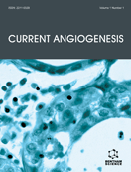Abstract
The progression of multiple myeloma depends on bone marrow microenvironment that can offer favorable conditions for its growth. Among the most important features of the disease is the alteration of bone marrow microenvironment, including dysregulation of various molecules with consequent increased angiogenic potential, extended bone disease, resistance to any likely therapy and furthermore direct growth of myeloma clone. Angiogenesis, as can be estimated by immunohistochemical staining of blood vessels, i.e. microvascular density, is a hallmark in the progress of many malignancies, including multiple myeloma. Many pro-angiogenic molecules participate in the process, being aberrantly or over-expressed by myeloma and other cells of bone marrow. Those molecules, possessing multiple properties, may circulate in peripheral blood and therefore could be measured. Here we present an overview of the most important molecules that participate, directly and indirectly, in the angiogenic process of multiple myeloma and try to evaluate their role, as factors of disease activity and moreover of prognosis. Furthermore, many of circulating angiogenic molecules have been constituted possible targets for therapeutic interventions. All this provided information contributes to a better comprehension of the complex pathophysiology of multiple myeloma.
Keywords: Angiogenesis, bone marrow, chemokines, cytokines, microvascular density, multiple myeloma, prognosis.
 47
47

